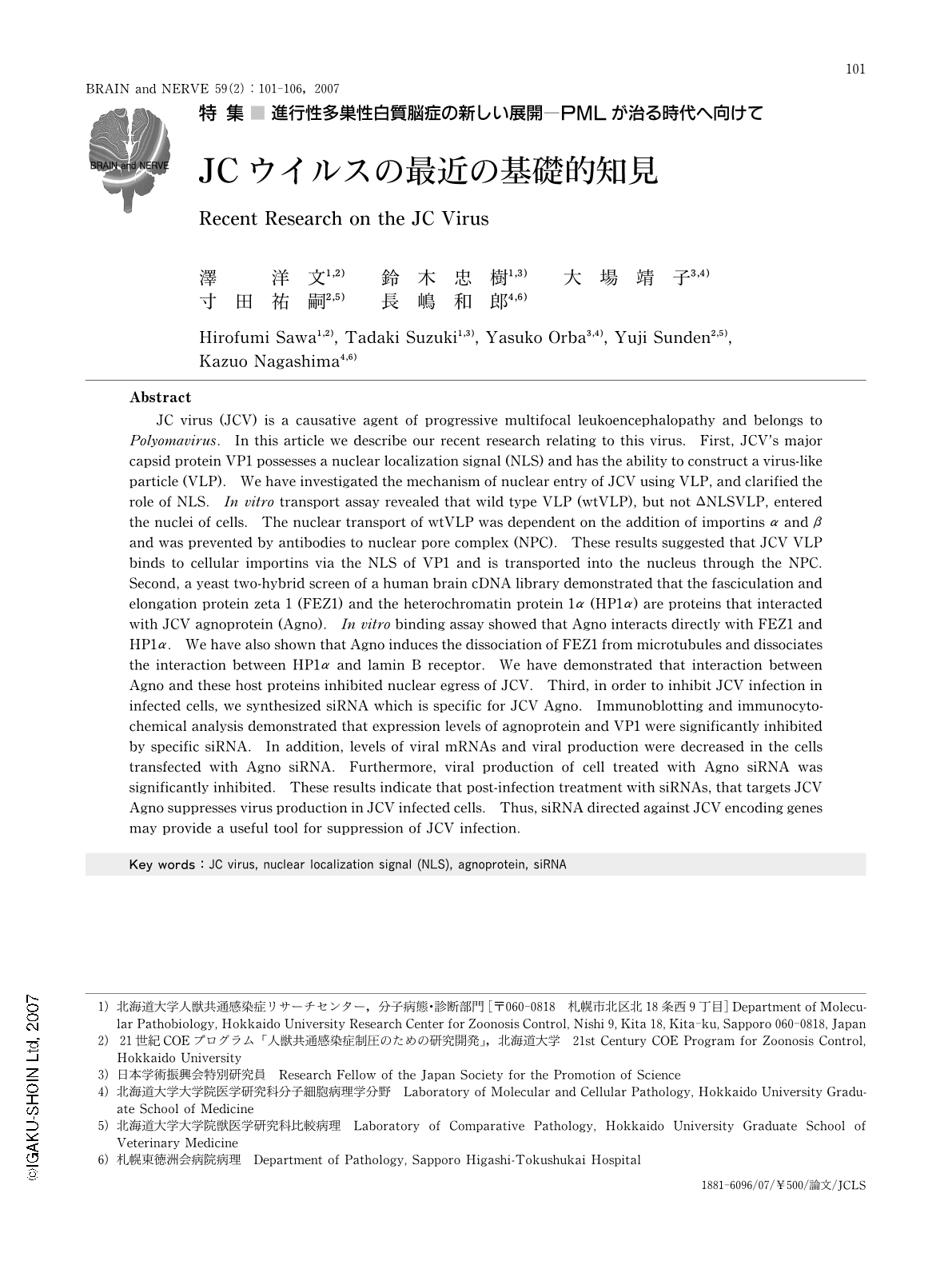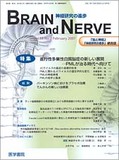Japanese
English
- 有料閲覧
- Abstract 文献概要
- 1ページ目 Look Inside
- 参考文献 Reference
はじめに
Polyomavirus科Polyomavirus属に分類される,二重鎖DNAウイルスであるJC virus(JCV)はヒト中枢神経に生じる進行性多巣性白質脳症(progressive multifocal leukoencephalopathy: PML)の原因ウイルスである。PMLはhuman immunodeficiency virus type-1(HIV-1)によるacquired immunodeficiency syndrome(AIDS)の増加や臓器移植の後の免疫抑制療法に伴い増加しているが,有効な治療法はいまだない。
認知症の症例に広範な脱髄病変が存在することは1930年に最初に報告されている。HallervordenはHandbuch der Geisteskrankheitenという成書に,45歳の結核の症例および71歳の硬膜下血腫の女性症例の脳病変について,「多発性硬化症と類似している脱髄が亜急性に進行し,組織像は多発性硬化症とは異なり,小脱髄層が白質に散在すること,腫大した核を持つ細胞が出現する」ということを記載しており,さらに病変の原因としてウイルスの関与も考えられることを指摘している1)。
その後1958年にchronic lymphocytic leukemiaおよびHodgkin's diseaseに関連した広汎な脱髄病変に対して,PMLという病名が初めて用いられた2)。PMLがウイルス性疾患であるという事実はzuRheinら,およびSilvermanらによって,1965年に電子顕微鏡検索により証明された3,4)。続いて1971年にPadgettらはPML症例の脳からウイルスを単離することに成功し,ウイルスを単離した症例の頭文字から,単離したウイルスをJC virus(JCV)と名付けた5)。
筆者らは1981年にJCV Tokyo-1株を分離して以来6),JCVの研究を行っており,本稿では,JCVの感染様式の最近得られた知見について報告する。
Abstract
JC virus (JCV) is a causative agent of progressive multifocal leukoencephalopathy and belongs to Polyomavirus. In this article we describe our recent research relating to this virus. First, JCV's major capsid protein VP1 possesses a nuclear localization signal (NLS)and has the ability to construct a virus-like particle (VLP). We have investigated the mechanism of nuclear entry of JCV using VLP,and clarified the role of NLS. In vitro transport assay revealed that wild type VLP (wtVLP), but not ΔNLSVLP, entered the nuclei of cells. The nuclear transport of wtVLP was dependent on the addition of importins α and β and was prevented by antibodies to nuclear pore complex (NPC). These results suggested that JCV VLP binds to cellular importins via the NLS of VP1 and is transported into the nucleus through the NPC. Second, a yeast two-hybrid screen of a human brain cDNA library demonstrated that the fasciculation and elongation protein zeta 1 (FEZ1) and the heterochromatin protein 1α(HP1α) are proteins that interacted with JCV agnoprotein (Agno). In vitro binding assay showed that Agno interacts directly with FEZ1 and HP1α. We have also shown that Agno induces the dissociation of FEZ1 from microtubules and dissociates the interaction between HP1α and lamin B receptor. We have demonstrated that interaction between Agno and these host proteins inhibited nuclear egress of JCV. Third, in order to inhibit JCV infection in infected cells, we synthesized siRNA which is specific for JCV Agno. Immunoblotting and immunocytochemical analysis demonstrated that expression levels of agnoprotein and VP1 were significantly inhibited by specific siRNA. In addition, levels of viral mRNAs and viral production were decreased in the cells transfected with Agno siRNA. Furthermore, viral production of cell treated with Agno siRNA was significantly inhibited. These results indicate that post-infection treatment with siRNAs, that targets JCV Agno suppresses virus production in JCV infected cells. Thus,siRNA directed against JCV encoding genes may provide a useful tool for suppression of JCV infection.

Copyright © 2007, Igaku-Shoin Ltd. All rights reserved.


